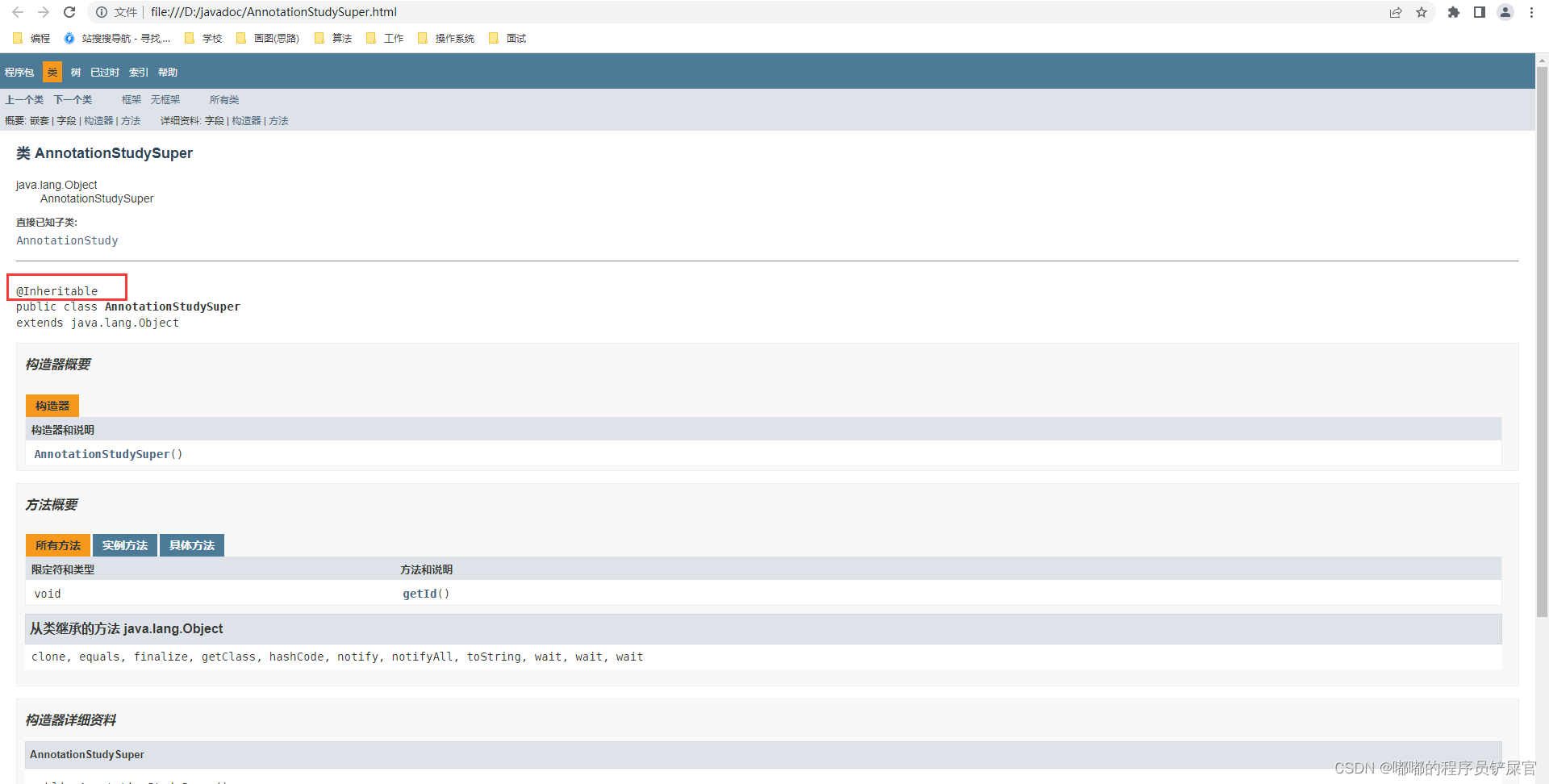本篇博文目录:
前言
📢📢📢本文主要是对这篇博文进行学习:https://www.cnblogs.com/skywang12345/p/3344137.html
一.理解什么是注解
我们常常在类、方法、字段、参数前看见一种以@开头的标记,这种标记叫做注解,是一种特殊带有相应功能的“注释”。
1.注解的框架图
理解注解之前先来看看注解的框架图(下图),从中我们可以看出:
- 1个Annotation接口关联1个RetentionPolicy类,关联1~n个ElementType类
- 1个Annotation接口具有多个实现类(Deprecated, Documented, Inherited, Override,Retention,Target…)
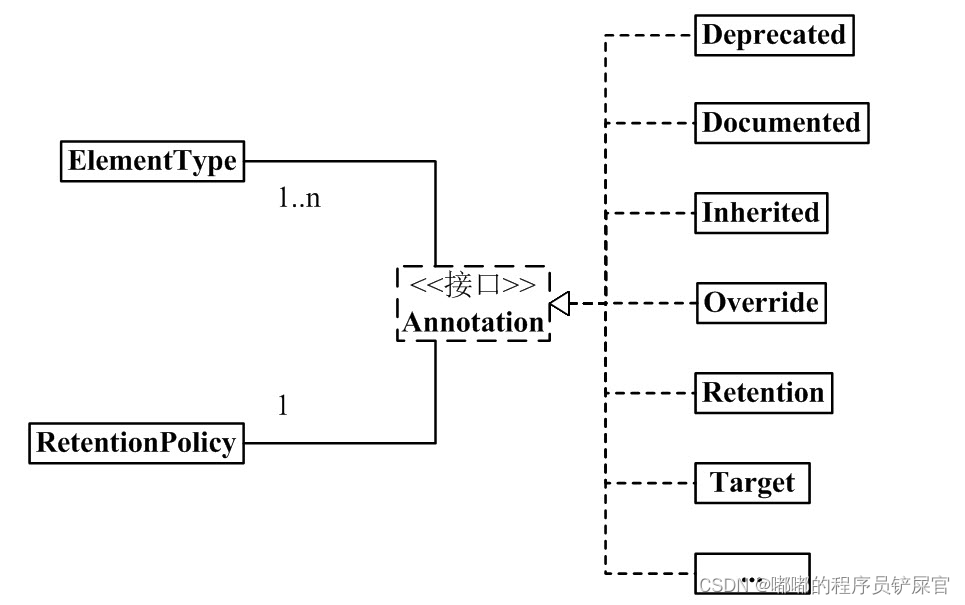
2.注解框架图的关联类
(1) Annotation接口
从下图的Annotation源码中我们可知:
- Annotation是一个接口,位于java.lang.annotation包下
- Annotation接口有4个抽象方法,equals(Object obj), hashCode(),toString(),annotationType()
- Annotation接口关联1个RetentionPolicy类和1~n个ElementType类。
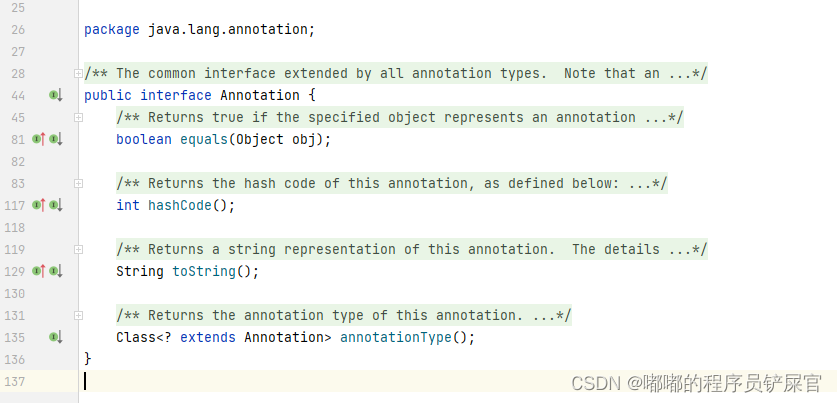
(2) RetentionPolicy类
从下图的RetentionPolicy源码中我们可知:
- RetentionPolicy是一个枚举类型,位于java.lang.annotation包下
- RetentionPolicy有三种类型,SOURCE,CLASS,RUNTIME
- 1个Annotation接口关联1个RetentionPolicy的类型
- RetentionPolicy可理解为给Annotation指定策略/作用域,这三种策略分别SOURCE,CLASS,RUNTIME
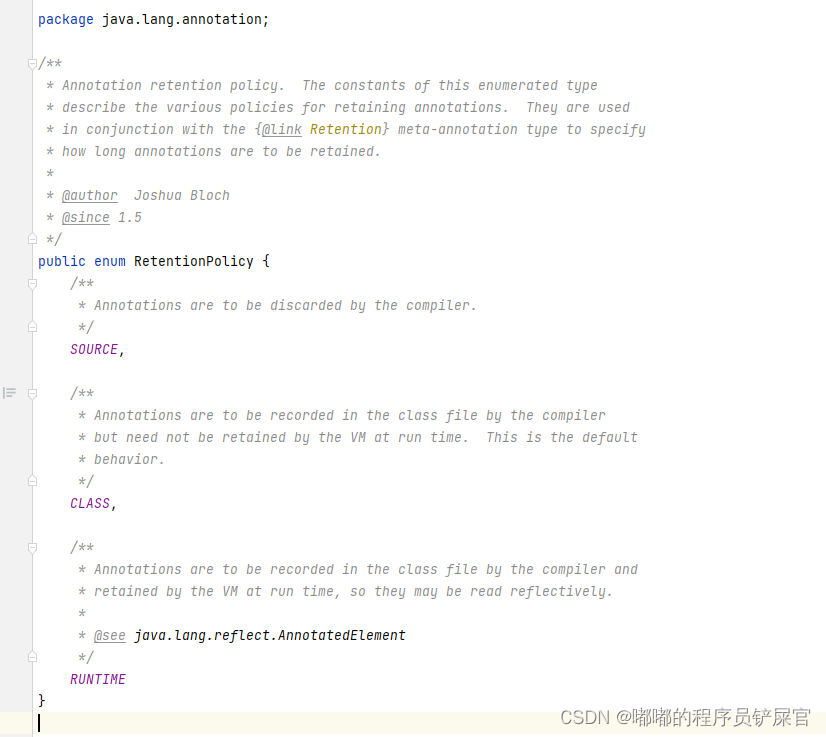
这三种类型的解释如下表所示:
| 类型 | 解释 |
|---|---|
| SOURCE | 表示Annotation信息仅存在于编译器处理期间,编译器处理完之后就没有该Annotation信息了 |
| CLASS | 表示编译器将Annotation存储于类对应的.class文件中,不会被加载进JVM。(默认行为) |
| RUNTIME | 表示编译器将Annotation存储于class文件中,并且可由JVM读入 |
(3) ElementType类
从下图的ElementType源码中我们可知:
- ElementType是一个枚举类型,位于java.lang.annotation包下
- ElementType包含10种类型,分别为: TYPE ,FIELD ,METHOD ,PARAMETER ,CONSTRUCTOR ,LOCAL_VARIABLE ,ANNOTATION_TYPE ,PACKAGE, TYPE_PARAMETER, TYPE_USE
- 1个Annotation接口关联1~n个ElementType的类型
- ElementType可理解为指定Annotation的元素类型
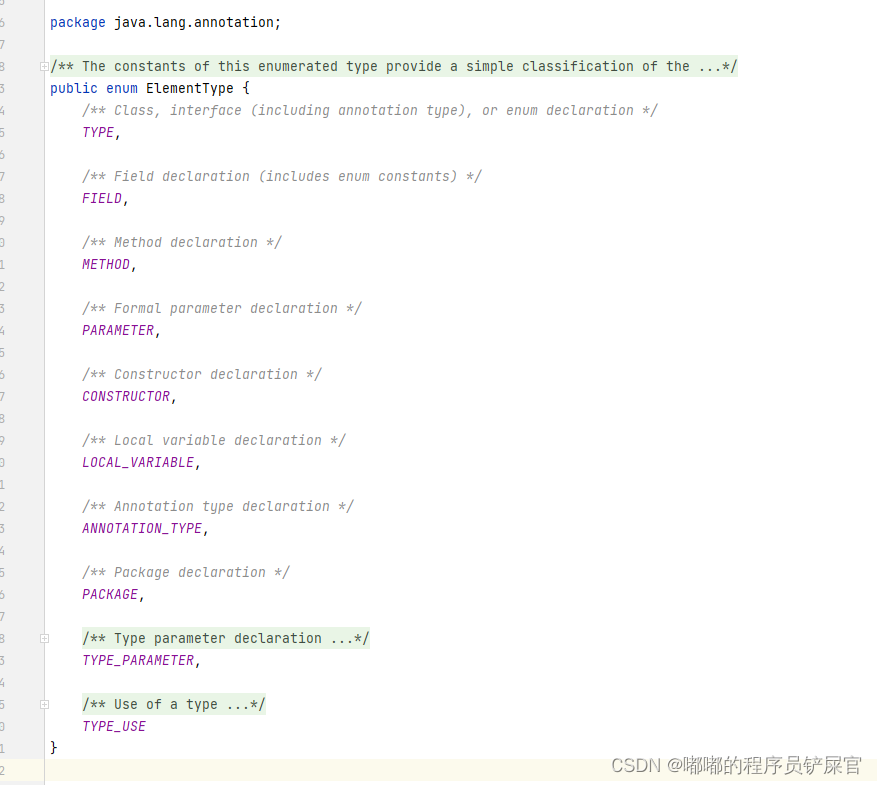
这10种类型的解释如下表所示:
| 类型 | 解释 |
|---|---|
| TYPE | 类、接口(包括注释类型)或枚举声明 |
| FIELD | 字段声明(包括枚举常量) |
| METHOD | 方法声明 |
| PARAMETER | 参数声明 |
| CONSTRUCTOR | 构造方法声明 |
| LOCAL_VARIABLE | 局部变量声明 |
| ANNOTATION_TYPE | 注释类型声明 |
| PACKAGE | 包声明 |
3.Annotation的实现类
(1) Annotation定义
理解了上面的3个类的作用之后,我们接下来可以讲解Annotation实现类的语法定义了。
@Documented
@Target(ElementType.TYPE)
@Retention(RetentionPolicy.RUNTIME)
public @interface MyAnnotation1 {
}
上面的作用是定义一个Annotation,它的名字是MyAnnotation1。定义了MyAnnotation1之后,我们可以在代码中通过“@MyAnnotation1”来使用它。
其它的,@Documented, @Target, @Retention, @interface注解都是来修饰MyAnnotation1的。下面分别说说它们的含义:
- @interface
使用@interface定义注解时,意味着它实现了java.lang.annotation.Annotation接口,即该注解就是一个Annotation。定义Annotation时,@interface是必须的。注意:它和我们通常的implemented实现接口的方法不同。Annotation接口的实现细节都由编译器完成。通过@interface定义注解后,该注解不能继承其他的注解或接口。
- @Documented
类和方法的Annotation在缺省情况下是不出现在javadoc中的。如果使用@Documented修饰该Annotation,则表示它可以出现在javadoc中。定义Annotation时,@Documented可有可无;若没有定义,则Annotation不会出现在javadoc中。
- @Target(ElementType.TYPE)
前面我们说过,ElementType是Annotation的类型属性。而@Target的作用,就是来指定Annotation的类型属性。@Target(ElementType.TYPE)的意思就是指定该Annotation的类型是ElementType.TYPE。这就意味着,MyAnnotation1是来修饰“类、接口(包括注释类型)或枚举声明”的注解。定义Annotation时,@Target可有可无。若有@Target,则该Annotation只能用于它所指定的地方;若没有@Target,则该Annotation可以用于任何地方。
- @Retention(RetentionPolicy.RUNTIME)
前面我们说过,RetentionPolicy是Annotation的策略属性,而@Retention的作用,就是指定Annotation的策略属性。@Retention(RetentionPolicy.RUNTIME)的意思就是指定该Annotation的策略是RetentionPolicy.RUNTIME。这就意味着,编译器会将该Annotation信息保留在.class文件中,并且能被虚拟机读取。定义Annotation时,@Retention可有可无。若没有@Retention,则默认是RetentionPolicy.CLASS。
备注:修饰其他注解的注解称为元注解。
注解定义的时候常常还定义一些参数,这些参数一般的数据类型如下:
- 所有基本类型;
- String;
- 枚举类型;
- 基本类型、String、Class以及枚举的数组。
定义参数如下:
@Documented
@Target(ElementType.TYPE) //这个注解可以在类,接口和枚举上使用
@Retention(RetentionPolicy.RUNTIME) // 作用域为运行时
@Inherited // 该注解可继承
@interface Inheritable{
int type() default 0;
String level() default "info";
String value() default "";
}
使用的时候就可以给注解相应参数赋值,这里赋的值都是常量,如下:

备注:注解常常都有一个value参数,该参数表示最常用的参数。
(2) Annotation的实现类
java 常用Annotation的实现类如下表所示:
| 注解 | 说明 |
|---|---|
| @Deprecated | 所标注内容,不再被建议使用。 |
| @Override | 只能标注方法,表示该方法覆盖父类中的方法。 |
| @Documented | 所标注内容,可以出现在javadoc中。 |
| @Inherited | 只能被用来标注“Annotation类型”,它所标注的Annotation具有继承性。 |
| @Retention | 只能被用来标注“Annotation类型”,而且它被用来指定Annotation的RetentionPolicy属性。 |
| @Target | 只能被用来标注“Annotation类型”,而且它被用来指定Annotation的ElementType属性。 |
| @SuppressWarnings | 所标注内容产生的警告,编译器会对这些警告保持静默。 |
被@Deprecated注解标注表示不在被建议使用,使用的时候会给出相应的提示信息,如下图:
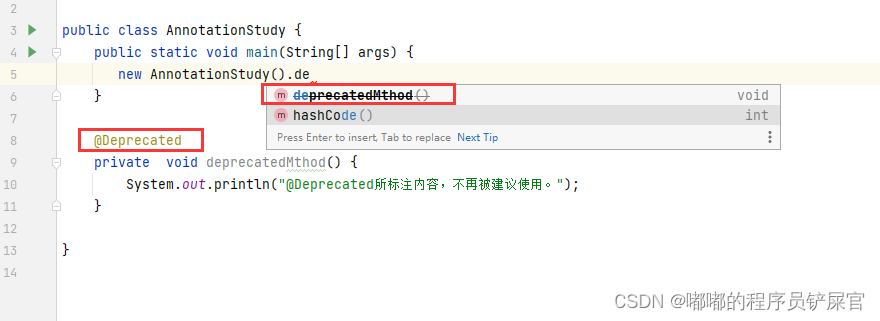
看看该注解的源码:
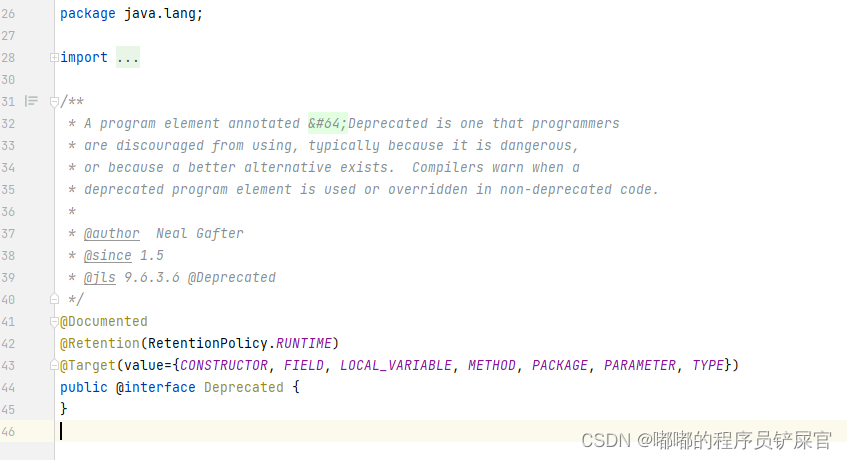
- @Documented表示该注解能出现在javadoc中。
- @Retention(RetentionPolicy.RUNTIME)表示指定注解的策略为RetentionPolicy.RUNTIME,这就意味着,编译器会将Deprecated的信息保留在.class文件中,并且能被虚拟机读取。
- @Target(value={CONSTRUCTOR, FIELD, LOCAL_VARIABLE, METHOD, PACKAGE,
PARAMETER, TYPE})指定注解的参数为CONSTRUCTOR, FIELD, LOCAL_VARIABLE, METHOD,
PACKAGE, PARAMETER, TYPE,表示该注解可以标注构造方法,字段,局部变量,方法,包,参数,类,接口和枚举。
备注:Retention里的参数只有一个,因为前面我们提到RetentionPolicy和Annotation的关联是1对1Target可以有多个这是因为ElementType和Annotation的关联是1~n对1,接下来就不在做任何注解解释了,你可以直接跳转到对应注解的源码,然后通过上面给出的相应表格查询相应说明。
@Override注解表示该方法覆盖父类中的方法:
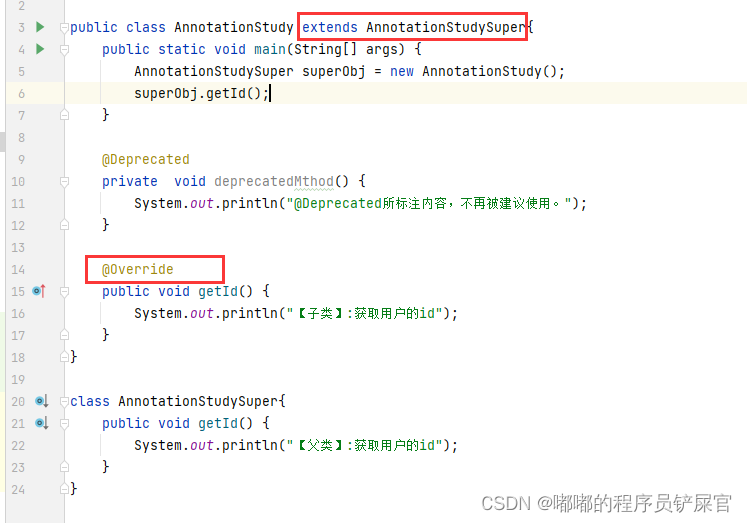
运行效果( 子类的getId()覆盖了父类的getId() ):
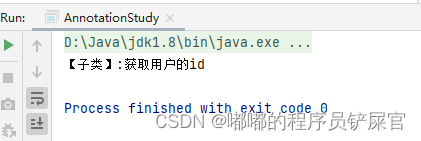
@Inherited注解只能被用来标注“Annotation类型”,它所标注的Annotation具有继承性。
例子:
下面的isAnnotationPresent()方法可以理解为某个注解是否在该类上,AnnotationStudy类继承AnnotationStudySuper类,在AnnotationStudySuper类上有一个自定义的@Inheritable可继承注解,所以它的子类AnnotationStudy也具有@Inheritable注解,。
import java.lang.annotation.*;
public class AnnotationStudy extends AnnotationStudySuper{
public AnnotationStudy() {
super(); // 调用父类的构造函数
// InheritableSon类是否具有 Inheritable Annotation
System.out.println("InheritableSon:"+AnnotationStudy.class.isAnnotationPresent(Inheritable.class));
}
public static void main(String[] args) {
AnnotationStudySuper superObj = new AnnotationStudy();
superObj.getId();
}
@Deprecated
private void deprecatedMthod() {
System.out.println("@Deprecated所标注内容,不再被建议使用。");
}
@Override
public void getId() {
System.out.println("【子类】:获取用户的id");
}
}
@Inheritable
class AnnotationStudySuper{
public AnnotationStudySuper() {
// InheritableBase是否具有 Inheritable Annotation
System.out.println("InheritableFather:"+AnnotationStudySuper.class.isAnnotationPresent(Inheritable.class));
}
public void getId() {
System.out.println("【父类】:获取用户的id");
}
}
@Target(ElementType.TYPE) //这个注解可以在类,接口和枚举上使用
@Retention(RetentionPolicy.RUNTIME) // 作用域为运行时
@Inherited // 该注解可继承
@interface Inheritable{
}
运行效果:
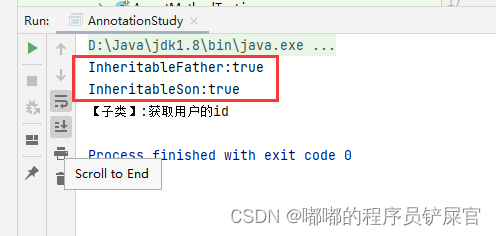
现在把@Inherited注解注释掉再次运行:
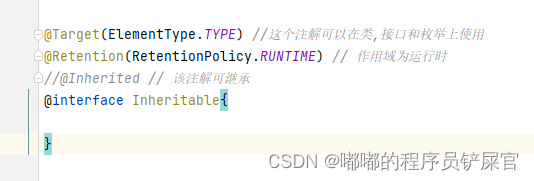
运行效果:
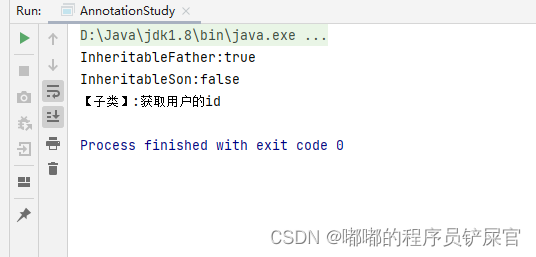
@SuppressWarnings注解所标注内容产生的警告,编译器会对这些警告保持静默。
使用Date date = new Date(113,8,26);时出现黄色警告,如下图所示:
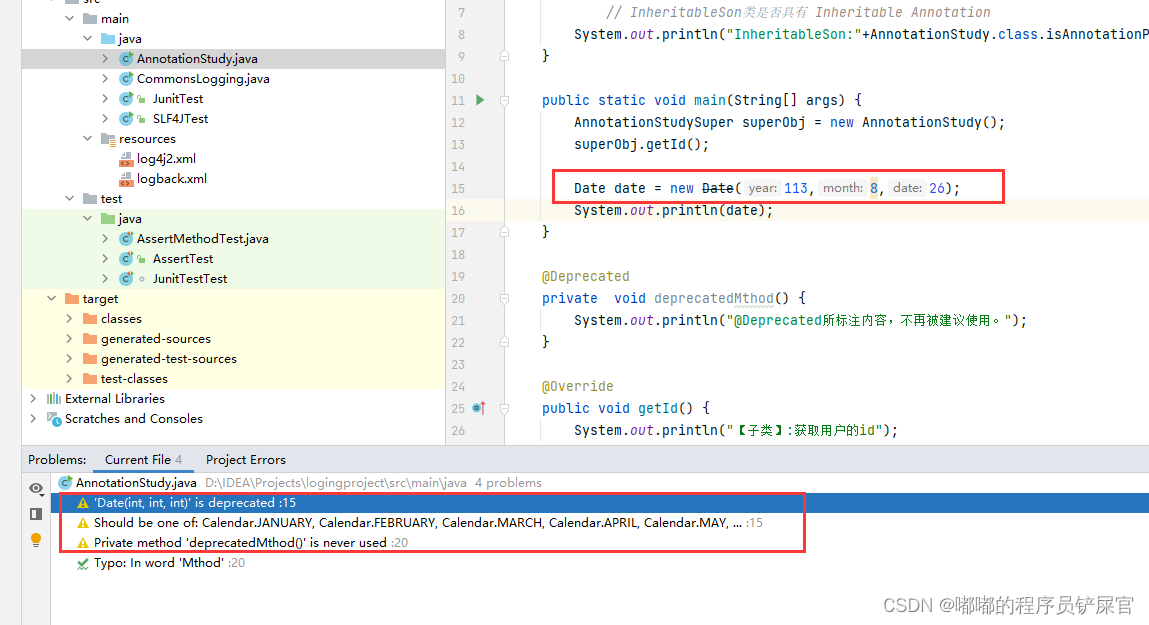
使用@SuppressWarnings注解
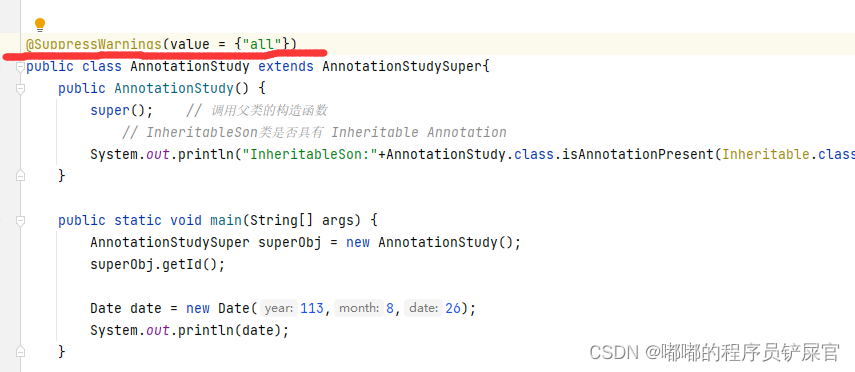
警告取消了!

@SuppressWarnings注解的参数如下图所示:
| 参数 | 解释 |
|---|---|
| deprecation | 使用了不赞成使用的类或方法时的警告 |
| unchecked | 执行了未检查的转换时的警告,例如当使用集合时没有用泛型 (Generics) 来指定集合保存的类型。 |
| fallthrough | 当 Switch 程序块直接通往下一种情况而没有 Break 时的警告。 |
| path | 在类路径、源文件路径等中有不存在的路径时的警告。 |
| serial | 当在可序列化的类上缺少 serialVersionUID 定义时的警告。 |
| finally | 任何 finally 子句不能正常完成时的警告。 |
| all | 关于以上所有情况的警告。 |
二.注解的作用
Annotation 是一个辅助类,它在Junit、Struts、Spring等工具框架中被广泛使用。我们在编程中经常会使用到的Annotation作用有:
- 编译检查
- 在反射中使用Annotation
- 根据Annotation生成帮助文档
- 能够帮忙查看查看代码
1.编译检查
Annotation具有“让编译器进行编译检查的作用”。
例如,@SuppressWarnings, @Deprecated和@Override都具有编译检查作用。
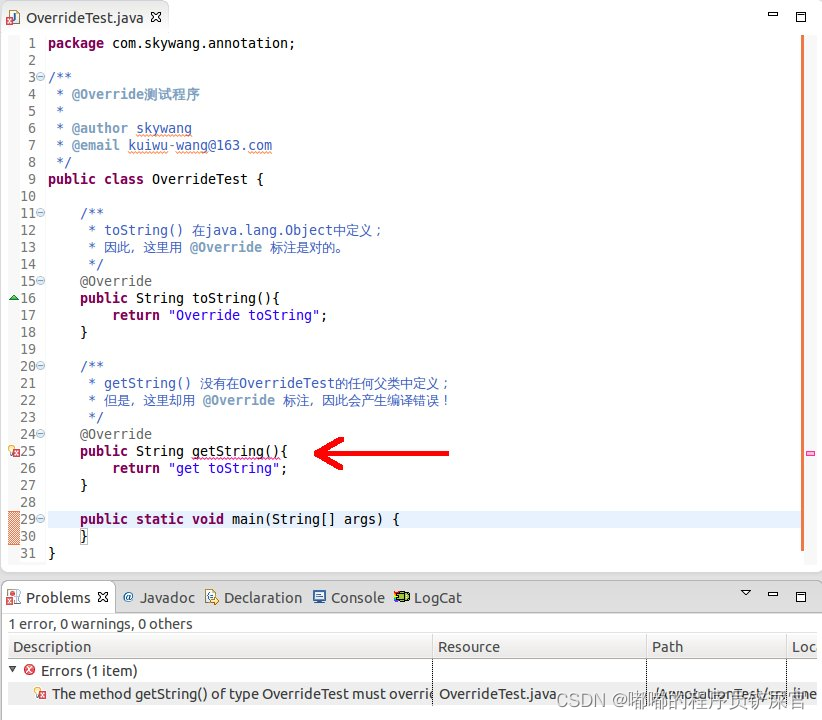
2.在反射中使用Annotation
在反射的Class, Method, Field等函数中,有许多关于Annotation相关的接口。这也意味着,我们可以在反射中解析并使用Annotation。
判断某个注解是否存在于Class、Field、Method或Constructor:
- Class.isAnnotationPresent(Class)
- Field.isAnnotationPresent(Class)
- Method.isAnnotationPresent(Class)
- Constructor.isAnnotationPresent(Class)
例如:
// 判断@Inheritable注解是否存在AnnotationStudySuper类中
boolean annotationPresent = AnnotationStudySuper.class.isAnnotationPresent(Inheritable.class);
使用反射API读取Annotation:
- Class.getAnnotation(Class)
- Field.getAnnotation(Class)
- Method.getAnnotation(Class)
- Constructor.getAnnotation(Class)
例如:
// 获取Person定义的@Report注解:
Inheritable annotation = AnnotationStudySuper.class.getAnnotation(Inheritable.class);
并且还可以直接通过注解获取相应的参数,如下:
System.out.println(annotation.level());
System.out.println(annotation.type());
System.out.println(annotation.value());
完整代码:
import java.lang.annotation.*;
@Inheritable(value = "10",level = "debug",type = 10)
public class AnnotationStudySuper{
public static void main(String[] args) {
// 判断@Inheritable注解是否存在AnnotationStudySuper类中
boolean annotationPresent = AnnotationStudySuper.class.isAnnotationPresent(Inheritable.class);
if (annotationPresent) {
Inheritable annotation = AnnotationStudySuper.class.getAnnotation(Inheritable.class);
System.out.println("@Inheritable注解是否存在AnnotationStudySuper类中:"+(annotationPresent == true?"是":"不是"));
if (annotation != null) {
System.out.println(annotation.level());
System.out.println(annotation.type());
System.out.println(annotation.value());
}
}
}
public AnnotationStudySuper() {
// InheritableBase是否具有 Inheritable Annotation
System.out.println("InheritableFather:"+AnnotationStudySuper.class.isAnnotationPresent(Inheritable.class));
}
public void getId() {
System.out.println("【父类】:获取用户的id");
}
}
@Documented
@Target(ElementType.TYPE) //这个注解可以在类,接口和枚举上使用
@Retention(RetentionPolicy.RUNTIME) // 作用域为运行时
@Inherited // 该注解可继承
@interface Inheritable{
int type() default 0;
String level() default "info";
String value() default "";
}
3.根据Annotation生成帮助文档
通过给Annotation注解加上@Documented标签,能使该Annotation标签出现在javadoc中。
给自定义注解加上@Documented标签
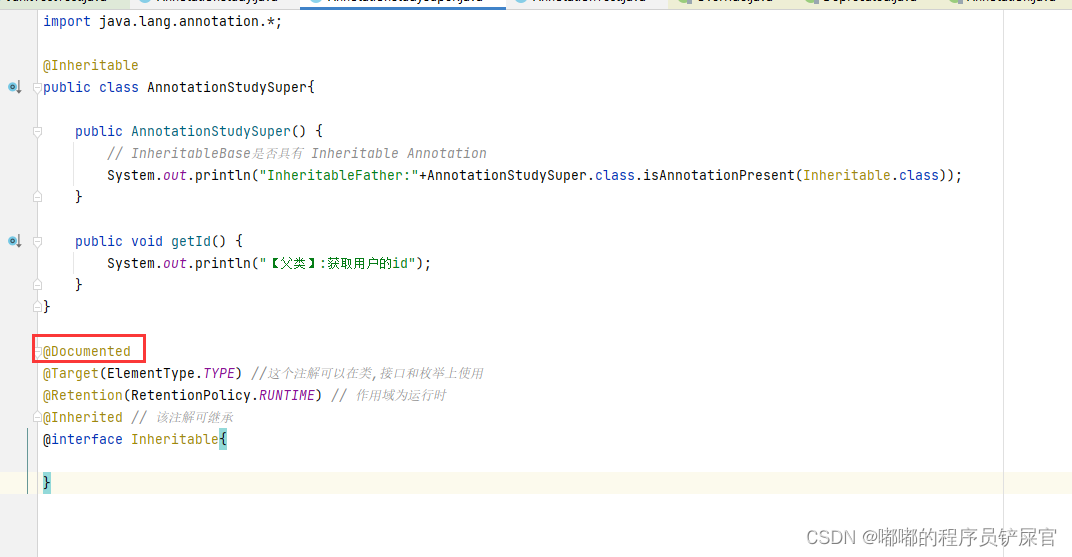
生成javadoc文档:
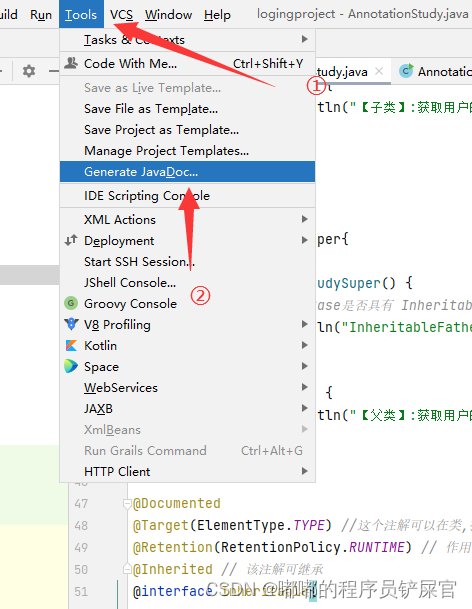
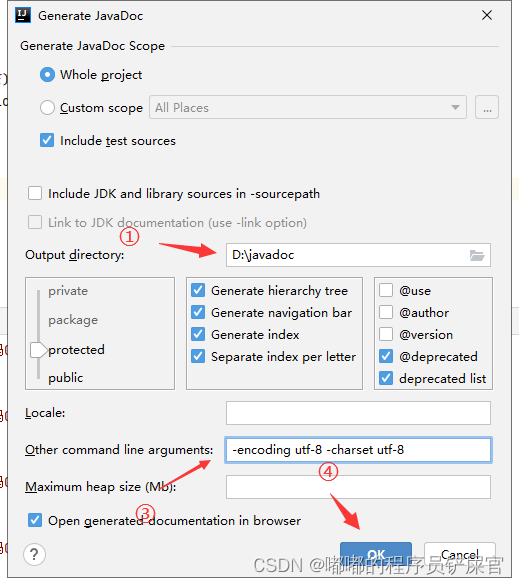
效果:
